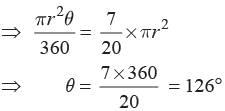All Exams >
Class 10 >
International Mathematics Olympiad (IMO) for Class 10 >
All Questions
All questions of Circles for Class 10 Exam
If PA and PB are tangents to the circle with centre O such that ∠APB = 40∘, then ∠OAB is equal to
- a)30∘
- b)40∘
- c)25∘
- d)20∘
Correct answer is option 'D'. Can you explain this answer?
If PA and PB are tangents to the circle with centre O such that ∠APB = 40∘, then ∠OAB is equal to
a)
30∘
b)
40∘
c)
25∘
d)
20∘

|
Parth Basu answered |
Let ∠OAB = ∠OBA = x [Opposite angles of opposite equal radii] And ∠AOB =180° - 40° = 140°
Now, in triangle AOB,
∠OAB + ∠OBA + ∠AOB = 180°
⇒ x + x +140° = 180°
⇒ 2x = 40°
⇒ x = 20°
∴ ∠OAB = 20°
Now, in triangle AOB,
∠OAB + ∠OBA + ∠AOB = 180°
⇒ x + x +140° = 180°
⇒ 2x = 40°
⇒ x = 20°
∴ ∠OAB = 20°
A circle is inscribed in ΔABC having sides 8 cm, 10 cm and 12 cm as shown in the figure. Then,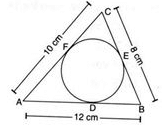
- a)AD = 7 cm, BE = 5 cm.
- b)AD = 8 cm, BE = 5 cm.
- c)AD = 8 cm, BE = 6 cm.
- d)AD = 5 cm, BE = 7 cm.
Correct answer is option 'A'. Can you explain this answer?
A circle is inscribed in ΔABC having sides 8 cm, 10 cm and 12 cm as shown in the figure. Then,
a)
AD = 7 cm, BE = 5 cm.
b)
AD = 8 cm, BE = 5 cm.
c)
AD = 8 cm, BE = 6 cm.
d)
AD = 5 cm, BE = 7 cm.
|
|
Arun Khatri answered |
Let AD = x and BE = y
∴ BD = 12 - x ⇒ BE = 12 - x [BD = BE = Tangents to a circle from an external point]
⇒ y = 12 - x ⇒ x+y = 12.......(i)
Also, AF = x and CF = 10 - x and CE = 8 - y
Also, AF = x and CF = 10 — x and CE = 8 - y
∴ 10 - x = 8 - yx - y = 2 (ii)
On solving eq. (i) and (ii), we get x = 7 and y = 5
⇒ AD = 7 cm and BE = 5cm
∴ BD = 12 - x ⇒ BE = 12 - x [BD = BE = Tangents to a circle from an external point]
⇒ y = 12 - x ⇒ x+y = 12.......(i)
Also, AF = x and CF = 10 - x and CE = 8 - y
Also, AF = x and CF = 10 — x and CE = 8 - y
∴ 10 - x = 8 - yx - y = 2 (ii)
On solving eq. (i) and (ii), we get x = 7 and y = 5
⇒ AD = 7 cm and BE = 5cm
At one end of a diameter PQ of a circle of radius 5 cm, tangent XPYis drawn to the circle. The length of chord AB parallel to XY and at a distance of 8 cm from P is- a)6 cm.
- b)5 cm.
- c)7 cm.
- d)8 cm
Correct answer is option 'D'. Can you explain this answer?
At one end of a diameter PQ of a circle of radius 5 cm, tangent XPYis drawn to the circle. The length of chord AB parallel to XY and at a distance of 8 cm from P is
a)
6 cm.
b)
5 cm.
c)
7 cm.
d)
8 cm

|
Prasad Chavan answered |
Here, OP = 00 = 5 cm [Radii]
And OR = PR - OP = 8 - 5 = 3 cm Also, OA = 5 cm [Radius]
Now, in triangle AOQ, OA2 = OR2 + AR2 ⇒ 52 = 32 + AR2
⇒AR2 = 25-9= 160 AR= 4cm
Since, perpendicular from centre of a circle to a chord bisects the chord.
∴ AB = AR+ BR = 4+ 4 = 8cm
And OR = PR - OP = 8 - 5 = 3 cm Also, OA = 5 cm [Radius]
Now, in triangle AOQ, OA2 = OR2 + AR2 ⇒ 52 = 32 + AR2
⇒AR2 = 25-9= 160 AR= 4cm
Since, perpendicular from centre of a circle to a chord bisects the chord.
∴ AB = AR+ BR = 4+ 4 = 8cm
The length of tangent PQ, from an external point P is 24 cm. If the distance of the point P from the centre is 25 cm, then the diameter of the circle is 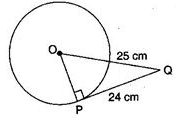
- a)7 cm
- b)14 cm.
- c)15 cm.
- d)12 cm
Correct answer is option 'B'. Can you explain this answer?
The length of tangent PQ, from an external point P is 24 cm. If the distance of the point P from the centre is 25 cm, then the diameter of the circle is
a)
7 cm
b)
14 cm.
c)
15 cm.
d)
12 cm

|
Swara Chopra answered |
Here ∠OPQ = 90°[Angle between tangent and radius through the point of contact]
∴ OQ2 = OP2 + PQ2 (25)2 = OP2 + (24)2 ⇒ OP2 = 625 - 576 ⇒ OP2 = 49
⇒ OP = 7 cm
Therefore, the diameter = 2 x OP = 2 x 7 = 14 cm
∴ OQ2 = OP2 + PQ2 (25)2 = OP2 + (24)2 ⇒ OP2 = 625 - 576 ⇒ OP2 = 49
⇒ OP = 7 cm
Therefore, the diameter = 2 x OP = 2 x 7 = 14 cm
In the given fig., if O is the centre of a circle, PQ is a chord and the tangent PR at P makes an angle of 50∘ with PQ, then ∠POQ is equal to :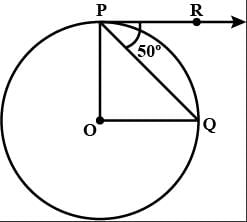
- a)90o
- b)75o
- c)100o
- d)80o
Correct answer is option 'C'. Can you explain this answer?
In the given fig., if O is the centre of a circle, PQ is a chord and the tangent PR at P makes an angle of 50∘ with PQ, then ∠POQ is equal to :

a)
90o
b)
75o
c)
100o
d)
80o
|
|
Abhishek Phogat answered |
Opq = 40 and also oqp.... Angle opp. to equal sides are equal... Hence poq +40 +40 = 180.....
POQ = 100....
POQ = 100....
In the given figure, perimeter of quadrilateral ABCD is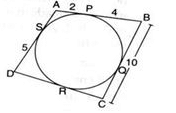
- a)48 units
- b)34 units
- c)36 units
- d)28 units
Correct answer is option 'B'. Can you explain this answer?
In the given figure, perimeter of quadrilateral ABCD is
a)
48 units
b)
34 units
c)
36 units
d)
28 units

|
Anjana Bajaj answered |
Here SD = RD = 5 units [Tangents from an external point]
And PB = QB = 4 cm [Tangents from an external point]
∴ QC = 10 - QB = 10 - 4 = 6 units
Also QC = RC = 6 units [Tangents from an extemal point]
∴ CD = RD + RC = 5 + 6 = 11 units
Also AP = AS = 2 units [Tangents from an external point]
∴ AD = AS + DS = 2 + 5 = 7 units Therefore. Perimeter of quadrilateral ABCD = 6 + 10 + 11 + 7 = 34 units
And PB = QB = 4 cm [Tangents from an external point]
∴ QC = 10 - QB = 10 - 4 = 6 units
Also QC = RC = 6 units [Tangents from an extemal point]
∴ CD = RD + RC = 5 + 6 = 11 units
Also AP = AS = 2 units [Tangents from an external point]
∴ AD = AS + DS = 2 + 5 = 7 units Therefore. Perimeter of quadrilateral ABCD = 6 + 10 + 11 + 7 = 34 units
The diameter of the front and rear wheels of a tractor are 80 cm and 200 cm respectively. What are the number of revolution that a rear wheel makes to cover the distance which the front wheel covers in 800 revolutions?- a)640
- b)320
- c)240
- d)300
Correct answer is option 'B'. Can you explain this answer?
The diameter of the front and rear wheels of a tractor are 80 cm and 200 cm respectively. What are the number of revolution that a rear wheel makes to cover the distance which the front wheel covers in 800 revolutions?
a)
640
b)
320
c)
240
d)
300
|
|
Aishwarya gupta answered |
To solve this problem, we can use the concept of the circumference of a circle and the relationship between the circumference and diameter.
Given:
Diameter of the front wheel = 80 cm
Diameter of the rear wheel = 200 cm
Step 1: Calculate the circumference of each wheel
Circumference of a circle = π * diameter
Circumference of the front wheel = π * 80 cm
Circumference of the rear wheel = π * 200 cm
Step 2: Find the ratio of the circumferences
Since the front and rear wheels are connected to the same axle, they will cover the same distance in one revolution. Therefore, the ratio of the circumferences is equal to the ratio of the number of revolutions.
Ratio of the circumferences = (Circumference of the rear wheel) / (Circumference of the front wheel)
Ratio of the circumferences = (π * 200 cm) / (π * 80 cm) = 200 cm / 80 cm = 5/2
Step 3: Find the number of revolutions the rear wheel makes to cover the distance covered by the front wheel in 800 revolutions
Since the ratio of the circumferences is equal to the ratio of the number of revolutions, we can set up the following proportion:
(Revolutions of the rear wheel) / 800 = 5/2
Cross-multiplying, we get:
2 * (Revolutions of the rear wheel) = 800 * 5
2 * (Revolutions of the rear wheel) = 4000
Revolutions of the rear wheel = 4000 / 2
Revolutions of the rear wheel = 2000
Therefore, the rear wheel makes 2000 revolutions to cover the distance covered by the front wheel in 800 revolutions.
Hence, the correct answer is option B) 320.
Given:
Diameter of the front wheel = 80 cm
Diameter of the rear wheel = 200 cm
Step 1: Calculate the circumference of each wheel
Circumference of a circle = π * diameter
Circumference of the front wheel = π * 80 cm
Circumference of the rear wheel = π * 200 cm
Step 2: Find the ratio of the circumferences
Since the front and rear wheels are connected to the same axle, they will cover the same distance in one revolution. Therefore, the ratio of the circumferences is equal to the ratio of the number of revolutions.
Ratio of the circumferences = (Circumference of the rear wheel) / (Circumference of the front wheel)
Ratio of the circumferences = (π * 200 cm) / (π * 80 cm) = 200 cm / 80 cm = 5/2
Step 3: Find the number of revolutions the rear wheel makes to cover the distance covered by the front wheel in 800 revolutions
Since the ratio of the circumferences is equal to the ratio of the number of revolutions, we can set up the following proportion:
(Revolutions of the rear wheel) / 800 = 5/2
Cross-multiplying, we get:
2 * (Revolutions of the rear wheel) = 800 * 5
2 * (Revolutions of the rear wheel) = 4000
Revolutions of the rear wheel = 4000 / 2
Revolutions of the rear wheel = 2000
Therefore, the rear wheel makes 2000 revolutions to cover the distance covered by the front wheel in 800 revolutions.
Hence, the correct answer is option B) 320.
A circle inscribed in DABC having AB = 10 cm, BC = 12 cm, CA = 28 cm touching sides at D, E, F (respectively). Then AD + BE + CF is ______.- a)25 cm
- b)20 cm
- c)22 cm
- d)18 cm
Correct answer is option 'A'. Can you explain this answer?
A circle inscribed in DABC having AB = 10 cm, BC = 12 cm, CA = 28 cm touching sides at D, E, F (respectively). Then AD + BE + CF is ______.
a)
25 cm
b)
20 cm
c)
22 cm
d)
18 cm
|
|
Vivek Bansal answered |
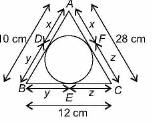
x + y = 10 cm ... (i)
y + z = 12 cm ... (ii)
x + z = 28cm ... (iii)
Adding (i), (ii) and (iii), we get
2(x + y + z) = 50
x + z = 28cm ... (iii)
Adding (i), (ii) and (iii), we get
2(x + y + z) = 50
⇒ x + y+ z = 25
In the given figure, If TP and TQ are two tangents to a circle with centre O, so that ∠POQ = 110o then ∠PTQ is equal to :

- a)80∘
- b)70∘
- c)60∘
- d)90∘
Correct answer is option 'B'. Can you explain this answer?
In the given figure, If TP and TQ are two tangents to a circle with centre O, so that ∠POQ = 110o then ∠PTQ is equal to :

a)
80∘
b)
70∘
c)
60∘
d)
90∘

|
Prasad Chavan answered |
Since the angle between the two tangents drawn from an external point to a circle in supplementary of the angle between the radii of the circle through the point of contact.
∴ ∠PTQ = 180∘−110∘ = 70∘
∴ ∠PTQ = 180∘−110∘ = 70∘
In the given figure, AB and PQ intersect at M. If A and B are centres of circles then _______.- a)PM = MQ
- b)PQ ⊥ AB
- c) Both (A) and (B)
- d)PQ = AB
Correct answer is option 'C'. Can you explain this answer?
In the given figure, AB and PQ intersect at M. If A and B are centres of circles then _______.
a)
PM = MQ
b)
PQ ⊥ AB
c)
Both (A) and (B)
d)
PQ = AB
|
|
Priyanka Kapoor answered |
In the given figure, PQ is the common chord of the two circles.
⇒ AB bisects the common chord PQ at M.
∴ PM = MQ
Moreover, PQ is perpendicular to AB.
∴ Option (C) is correct.
∴ PM = MQ
Moreover, PQ is perpendicular to AB.
∴ Option (C) is correct.
The radii of two concentric circles are 13 cm and 8 cm. AB is a diameter of the the bigger circle. BD is a tangent to the smaller circle touching it at D. Find the length AD.- a)19 cm
- b)20 cm
- c)16 cm
- d)√105
Correct answer is option 'A'. Can you explain this answer?
The radii of two concentric circles are 13 cm and 8 cm. AB is a diameter of the the bigger circle. BD is a tangent to the smaller circle touching it at D. Find the length AD.
a)
19 cm
b)
20 cm
c)
16 cm
d)
√105
|
|
Seema joshi answered |
To find the length AD, we can use the Pythagorean theorem.
Since AB is a diameter of the bigger circle, its length is equal to the diameter of the bigger circle, which is twice the radius. So, AB = 2 * 13 cm = 26 cm.
Since BD is tangent to the smaller circle, it is perpendicular to AD. Therefore, triangle ABD is a right triangle.
Using the Pythagorean theorem, we have:
(AD)^2 + (BD)^2 = (AB)^2
(AD)^2 + (8 cm)^2 = (26 cm)^2
(AD)^2 + 64 cm^2 = 676 cm^2
(AD)^2 = 676 cm^2 - 64 cm^2
(AD)^2 = 612 cm^2
AD = √(612 cm^2)
AD ≈ 24.7 cm
Therefore, the length AD is approximately 24.7 cm.
Since AB is a diameter of the bigger circle, its length is equal to the diameter of the bigger circle, which is twice the radius. So, AB = 2 * 13 cm = 26 cm.
Since BD is tangent to the smaller circle, it is perpendicular to AD. Therefore, triangle ABD is a right triangle.
Using the Pythagorean theorem, we have:
(AD)^2 + (BD)^2 = (AB)^2
(AD)^2 + (8 cm)^2 = (26 cm)^2
(AD)^2 + 64 cm^2 = 676 cm^2
(AD)^2 = 676 cm^2 - 64 cm^2
(AD)^2 = 612 cm^2
AD = √(612 cm^2)
AD ≈ 24.7 cm
Therefore, the length AD is approximately 24.7 cm.
Let s denote the semiperimeter of a triangle ABC in which BC = a, CA = b, AB = c. If a circle touches the sides BC, CA, AB at D, E, F, respectively, find BD.- a)s – b
- b)2s + h
- c)b + s
- d)3b – s
Correct answer is option 'A'. Can you explain this answer?
Let s denote the semiperimeter of a triangle ABC in which BC = a, CA = b, AB = c. If a circle touches the sides BC, CA, AB at D, E, F, respectively, find BD.
a)
s – b
b)
2s + h
c)
b + s
d)
3b – s
|
|
Niharika dasgupta answered |
By the property of a circle tangent to a line, we know that the line segment from the center of the circle to the point of tangency is perpendicular to the line. Therefore, let O be the center of the circle and let M, N, and P be the midpoints of BC, CA, and AB respectively.
Since O is the incenter of triangle ABC, O is equidistant from the sides of the triangle. Therefore, OM = ON = OP.
We can draw radii from O to the points of tangency D, E, and F. Let r be the length of these radii. Then, OD = OE = OF = r.
Since OM = ON = OP, we have that MD = NE = PF = s - a, where s is the semiperimeter of triangle ABC.
By the Pythagorean Theorem, we have that BD^2 = BM^2 + MD^2. Since BM = a/2 and MD = s - a, we have that BD^2 = (a/2)^2 + (s - a)^2.
Expanding and simplifying, we have that BD^2 = a^2/4 + s^2 - 2as + a^2.
Rearranging terms, we have that BD^2 = s^2 - 2as + a^2/4 + a^2.
Factoring, we have that BD^2 = (s - a/2)^2 + a^2/4.
Taking the square root of both sides, we have that BD = sqrt((s - a/2)^2 + a^2/4).
Therefore, the length of BD is sqrt((s - a/2)^2 + a^2/4).
Answer: a) sqrt((s - a/2)^2 + a^2/4)
Since O is the incenter of triangle ABC, O is equidistant from the sides of the triangle. Therefore, OM = ON = OP.
We can draw radii from O to the points of tangency D, E, and F. Let r be the length of these radii. Then, OD = OE = OF = r.
Since OM = ON = OP, we have that MD = NE = PF = s - a, where s is the semiperimeter of triangle ABC.
By the Pythagorean Theorem, we have that BD^2 = BM^2 + MD^2. Since BM = a/2 and MD = s - a, we have that BD^2 = (a/2)^2 + (s - a)^2.
Expanding and simplifying, we have that BD^2 = a^2/4 + s^2 - 2as + a^2.
Rearranging terms, we have that BD^2 = s^2 - 2as + a^2/4 + a^2.
Factoring, we have that BD^2 = (s - a/2)^2 + a^2/4.
Taking the square root of both sides, we have that BD = sqrt((s - a/2)^2 + a^2/4).
Therefore, the length of BD is sqrt((s - a/2)^2 + a^2/4).
Answer: a) sqrt((s - a/2)^2 + a^2/4)
AB is a chord of length 24 cm of a circle of radius 13 cm. The tangents at A and B intersect at a point C. Find the length AC.- a)31.2 cm
- b)12 cm
- c)28.8 cm
- d)25 cm
Correct answer is option 'A'. Can you explain this answer?
AB is a chord of length 24 cm of a circle of radius 13 cm. The tangents at A and B intersect at a point C. Find the length AC.
a)
31.2 cm
b)
12 cm
c)
28.8 cm
d)
25 cm
|
|
Ritu Saxena answered |
Given, Chord AB = 24 cm, Radius OB = OA = 13 cm.
Draw OP ⊥ AB
In D OPB, OP ⊥ AB ⇒ AP = PB
[Perpendicular from centre on chord bisect the chord] =(1/2)AB= 12
Also, OB2 = OP2 + PB2
⇒ (13)2 = OP2 + PB2 ⇒ 169 = OP2 + (12)2
⇒ OP2 = 169 - 144 = 25 ⇒ OP = 5 cm
In Δ BPC, BC2 = x2 + BP2 [By pythagoras theorem]
BC2 = x2 + 144 ...(i)
In ΔOBC, OC2 = OB2 + BC2
⇒ (x + 5)2 = (13)2 + BC2 ⇒ x = 288/10=28.8cm
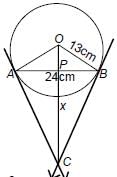
Put the value of x in (i), we get
BC2 = x2 + 144 = ((144)2/25) + 144⇒ BC = 31.2
⇒ AC = BC = 31.2 cm
Draw OP ⊥ AB
In D OPB, OP ⊥ AB ⇒ AP = PB
[Perpendicular from centre on chord bisect the chord] =(1/2)AB= 12
Also, OB2 = OP2 + PB2
⇒ (13)2 = OP2 + PB2 ⇒ 169 = OP2 + (12)2
⇒ OP2 = 169 - 144 = 25 ⇒ OP = 5 cm
In Δ BPC, BC2 = x2 + BP2 [By pythagoras theorem]
BC2 = x2 + 144 ...(i)
In ΔOBC, OC2 = OB2 + BC2
⇒ (x + 5)2 = (13)2 + BC2 ⇒ x = 288/10=28.8cm

Put the value of x in (i), we get
BC2 = x2 + 144 = ((144)2/25) + 144⇒ BC = 31.2
⇒ AC = BC = 31.2 cm
Quadrilateral PQRS circumscribes a circle as shown in the figure. The side of the quadrilateral which is equal to PD + QB is
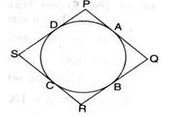
- a)QR
- b)PS
- c)PR
- d)PQ
Correct answer is option 'D'. Can you explain this answer?
Quadrilateral PQRS circumscribes a circle as shown in the figure. The side of the quadrilateral which is equal to PD + QB is

a)
QR
b)
PS
c)
PR
d)
PQ
|
|
Learnever Education answered |
PD + QB = PA + QA [Tangents from an external point to a circle are equal]
⇒PD + QB = PQ
⇒PD + QB = PQ
In a circle of radius 10.5 cm, the minor arc is one-fifth of the major arc. What is the area of major arc?- a)288.75 cm2
- b)281.75 cm2
- c)271.25 cm2
- d)262.75 cm2
Correct answer is option 'A'. Can you explain this answer?
In a circle of radius 10.5 cm, the minor arc is one-fifth of the major arc. What is the area of major arc?
a)
288.75 cm2
b)
281.75 cm2
c)
271.25 cm2
d)
262.75 cm2
|
|
Priyanka Kapoor answered |
Let the major arc be x cm.
Length of minor arc = x/5
Circumference =
⇒
⇒
⇒ x = 55 cm
Required area =
= 288.75 cm2.
Length of minor arc = x/5
Circumference =

⇒

⇒

⇒ x = 55 cm
Required area =

= 288.75 cm2.
The perimeter of a sector of a circle of radius 5.2 cm is 16.4 cm, then what is area of sector?- a)14.6 cm2
- b)15.6 cm2
- c)19.6 cm2
- d)None of these
Correct answer is option 'B'. Can you explain this answer?
The perimeter of a sector of a circle of radius 5.2 cm is 16.4 cm, then what is area of sector?
a)
14.6 cm2
b)
15.6 cm2
c)
19.6 cm2
d)
None of these
|
|
Priyanka Kapoor answered |
Let O be the centre of a circle of radius 5.2 cm. Let OABO be the sector with perimeter 16.4 cm.
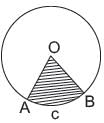
OA + O B + arc AB = 27.2
5.2 + 5 .2 + arc AB = 16.4
⇒ arc AB = 16.4 - 16.4 = 6 cm
Area of sector OACBO


OA + O B + arc AB = 27.2
5.2 + 5 .2 + arc AB = 16.4
⇒ arc AB = 16.4 - 16.4 = 6 cm
Area of sector OACBO

A field is in the form of a circle. The cost of ploughing the field at Rs. 1.50 per m2 is Rs. 5775. Find the cost of fencing the field at Rs. 8.50 per meter.- a)Rs. 1870
- b)Rs. 1670
- c)Rs. 1980
- d)Rs. 1780
Correct answer is option 'A'. Can you explain this answer?
A field is in the form of a circle. The cost of ploughing the field at Rs. 1.50 per m2 is Rs. 5775. Find the cost of fencing the field at Rs. 8.50 per meter.
a)
Rs. 1870
b)
Rs. 1670
c)
Rs. 1980
d)
Rs. 1780
|
|
Priyanka Kapoor answered |
Area of the circular filed = 
πr2 = 3850

r = 35 m
Circumference = 2πr = = 220 m
= 220 m
Cost of fencing = 220 × 8.50 = Rs. 1870

πr2 = 3850

r = 35 m
Circumference = 2πr =
 = 220 m
= 220 mCost of fencing = 220 × 8.50 = Rs. 1870
The minute hand of a clock is 12 cm long. Find the area of the face of the clock described by the minute hand in 35 minutes.- a)252 cm2
- b)264 cm2
- c)184 cm2
- d)1284 cm2
Correct answer is option 'B'. Can you explain this answer?
The minute hand of a clock is 12 cm long. Find the area of the face of the clock described by the minute hand in 35 minutes.
a)
252 cm2
b)
264 cm2
c)
184 cm2
d)
1284 cm2
|
|
Smita das answered |
To find the area of the face of the clock described by the minute hand in 35 minutes, we need to find the length of the arc covered by the minute hand and then use it to calculate the area.
Length of Arc Covered by the Minute Hand:
The minute hand of the clock is 12 cm long. In 60 minutes, it covers a complete circle, which is equivalent to the circumference of the clock face. The formula for the circumference of a circle is given by:
C = 2πr
where C is the circumference and r is the radius.
In this case, the radius is equal to the length of the minute hand, which is 12 cm. So, the circumference of the clock face is:
C = 2π(12) = 24π cm
In 60 minutes, the minute hand covers the entire circumference. Therefore, in 35 minutes, it covers:
35/60 * 24π = 7/12 * 24π = 14π cm
Area of the Face of the Clock:
To find the area of the face of the clock described by the minute hand in 35 minutes, we need to calculate the area of the sector formed by the minute hand.
The formula for the area of a sector of a circle is given by:
A = (θ/360) * πr^2
where A is the area, θ is the central angle in degrees, and r is the radius.
In this case, the central angle is 35/60 * 360 = 210 degrees (since the minute hand covers 35 minutes out of 60 minutes, and each minute corresponds to 6 degrees on the clock face).
Substituting the values into the formula, we get:
A = (210/360) * π(12)^2
= (7/12) * π(144)
= 7π * 12
= 84π cm^2
Approximating π to 3.14, we have:
Area = 84 * 3.14
≈ 264 cm^2
Therefore, the area of the face of the clock described by the minute hand in 35 minutes is approximately 264 cm^2.
Hence, option B is the correct answer.
Length of Arc Covered by the Minute Hand:
The minute hand of the clock is 12 cm long. In 60 minutes, it covers a complete circle, which is equivalent to the circumference of the clock face. The formula for the circumference of a circle is given by:
C = 2πr
where C is the circumference and r is the radius.
In this case, the radius is equal to the length of the minute hand, which is 12 cm. So, the circumference of the clock face is:
C = 2π(12) = 24π cm
In 60 minutes, the minute hand covers the entire circumference. Therefore, in 35 minutes, it covers:
35/60 * 24π = 7/12 * 24π = 14π cm
Area of the Face of the Clock:
To find the area of the face of the clock described by the minute hand in 35 minutes, we need to calculate the area of the sector formed by the minute hand.
The formula for the area of a sector of a circle is given by:
A = (θ/360) * πr^2
where A is the area, θ is the central angle in degrees, and r is the radius.
In this case, the central angle is 35/60 * 360 = 210 degrees (since the minute hand covers 35 minutes out of 60 minutes, and each minute corresponds to 6 degrees on the clock face).
Substituting the values into the formula, we get:
A = (210/360) * π(12)^2
= (7/12) * π(144)
= 7π * 12
= 84π cm^2
Approximating π to 3.14, we have:
Area = 84 * 3.14
≈ 264 cm^2
Therefore, the area of the face of the clock described by the minute hand in 35 minutes is approximately 264 cm^2.
Hence, option B is the correct answer.
A copper wire when bent in the form of a square encloses an area of 484 cm2. The same wire is now bent in the form of a circle. Find the area enclosed by the circle.- a)616 cm2
- b)456 cm2
- c)216 cm2
- d)None of these
Correct answer is option 'A'. Can you explain this answer?
A copper wire when bent in the form of a square encloses an area of 484 cm2. The same wire is now bent in the form of a circle. Find the area enclosed by the circle.
a)
616 cm2
b)
456 cm2
c)
216 cm2
d)
None of these

|
Anoushka Nambiar answered |
To solve this problem, we need to use the formulas for the area of a square and the area of a circle.
1. Area of a square:
The area of a square can be found by multiplying the length of one side by itself. Therefore, if the copper wire is bent in the form of a square and encloses an area of 484 cm^2, we can find the length of one side using the formula:
Area of square = side^2
484 = side^2
Taking the square root of both sides, we get:
side = √484
side = 22 cm
2. Perimeter of a square:
The perimeter of a square can be found by multiplying the length of one side by 4. In this case, the perimeter of the square formed by the copper wire is:
Perimeter of square = 4 * side
Perimeter of square = 4 * 22
Perimeter of square = 88 cm
3. Circumference of a circle:
The circumference of a circle can be found using the formula:
Circumference = π * diameter
Since the copper wire is bent in the form of a square, the length of the wire is equal to the perimeter of the square. Therefore, the circumference of the circle formed by the copper wire is:
Circumference of circle = 88 cm
4. Radius of the circle:
To find the radius of the circle, we can use the formula:
Radius = Circumference / (2 * π)
Radius = 88 / (2 * 3.14)
Radius ≈ 14 cm
5. Area of a circle:
Finally, we can find the area of the circle using the formula:
Area of circle = π * radius^2
Area of circle = 3.14 * 14^2
Area of circle ≈ 3.14 * 196
Area of circle ≈ 615.44 cm^2
Therefore, the area enclosed by the circle formed by the copper wire is approximately 616 cm^2, which corresponds to option A.
1. Area of a square:
The area of a square can be found by multiplying the length of one side by itself. Therefore, if the copper wire is bent in the form of a square and encloses an area of 484 cm^2, we can find the length of one side using the formula:
Area of square = side^2
484 = side^2
Taking the square root of both sides, we get:
side = √484
side = 22 cm
2. Perimeter of a square:
The perimeter of a square can be found by multiplying the length of one side by 4. In this case, the perimeter of the square formed by the copper wire is:
Perimeter of square = 4 * side
Perimeter of square = 4 * 22
Perimeter of square = 88 cm
3. Circumference of a circle:
The circumference of a circle can be found using the formula:
Circumference = π * diameter
Since the copper wire is bent in the form of a square, the length of the wire is equal to the perimeter of the square. Therefore, the circumference of the circle formed by the copper wire is:
Circumference of circle = 88 cm
4. Radius of the circle:
To find the radius of the circle, we can use the formula:
Radius = Circumference / (2 * π)
Radius = 88 / (2 * 3.14)
Radius ≈ 14 cm
5. Area of a circle:
Finally, we can find the area of the circle using the formula:
Area of circle = π * radius^2
Area of circle = 3.14 * 14^2
Area of circle ≈ 3.14 * 196
Area of circle ≈ 615.44 cm^2
Therefore, the area enclosed by the circle formed by the copper wire is approximately 616 cm^2, which corresponds to option A.
The side of a square is 10 cm. What is the area of circumscribed circle?- a)78.5 cm2
- b)157 cm2
- c)135 cm2
- d)314 cm2
Correct answer is option 'B'. Can you explain this answer?
The side of a square is 10 cm. What is the area of circumscribed circle?
a)
78.5 cm2
b)
157 cm2
c)
135 cm2
d)
314 cm2

|
Ashish Choudhary answered |
Given:
Side of the square = 10 cm
To find:
The area of the circumscribed circle.
Solution:
To find the area of the circumscribed circle, we need to find the radius of the circle first.
Finding the radius:
The diagonal of a square divides it into two congruent right-angled triangles.
Let's consider one of these triangles.
In a right-angled triangle, the hypotenuse (diagonal of the square) is equal to the diameter of the circle and the length of one side of the square is equal to the radius of the circle.
Using the Pythagorean theorem, we can find the length of the diagonal of the square:
(diagonal)^2 = (side)^2 + (side)^2
(diagonal)^2 = 10^2 + 10^2
(diagonal)^2 = 100 + 100
(diagonal)^2 = 200
diagonal = √200 = 10√2 cm
Since the diagonal of the square is equal to the diameter of the circle, the diameter of the circle is 10√2 cm.
So, the radius of the circle = (10√2)/2 = 5√2 cm.
Finding the area of the circle:
The area of a circle is given by the formula: A = πr^2, where r is the radius of the circle.
Substituting the value of the radius, we get:
A = π(5√2)^2
A = π(25*2)
A = 50π cm^2
Now, let's approximate the value of π to 3.14.
A ≈ 50 * 3.14
A ≈ 157 cm^2
Therefore, the area of the circumscribed circle is approximately 157 cm^2.
Answer:
The correct answer is option b) 157 cm^2.
Side of the square = 10 cm
To find:
The area of the circumscribed circle.
Solution:
To find the area of the circumscribed circle, we need to find the radius of the circle first.
Finding the radius:
The diagonal of a square divides it into two congruent right-angled triangles.
Let's consider one of these triangles.
In a right-angled triangle, the hypotenuse (diagonal of the square) is equal to the diameter of the circle and the length of one side of the square is equal to the radius of the circle.
Using the Pythagorean theorem, we can find the length of the diagonal of the square:
(diagonal)^2 = (side)^2 + (side)^2
(diagonal)^2 = 10^2 + 10^2
(diagonal)^2 = 100 + 100
(diagonal)^2 = 200
diagonal = √200 = 10√2 cm
Since the diagonal of the square is equal to the diameter of the circle, the diameter of the circle is 10√2 cm.
So, the radius of the circle = (10√2)/2 = 5√2 cm.
Finding the area of the circle:
The area of a circle is given by the formula: A = πr^2, where r is the radius of the circle.
Substituting the value of the radius, we get:
A = π(5√2)^2
A = π(25*2)
A = 50π cm^2
Now, let's approximate the value of π to 3.14.
A ≈ 50 * 3.14
A ≈ 157 cm^2
Therefore, the area of the circumscribed circle is approximately 157 cm^2.
Answer:
The correct answer is option b) 157 cm^2.
Two circles of radii 10 cm and 8 cm intersect each other and the length of common chord is 12 cm. The distance between their centres is.- a)√7 cm
- b)3√7 cm
- c)4√7 cm
- d)(8 + 2√7) cm
Correct answer is option 'D'. Can you explain this answer?
Two circles of radii 10 cm and 8 cm intersect each other and the length of common chord is 12 cm. The distance between their centres is.
a)
√7 cm
b)
3√7 cm
c)
4√7 cm
d)
(8 + 2√7) cm

|
Akanksha Deshpande answered |
To find the distance between the centers of the two circles, we can draw a line connecting the centers and draw a perpendicular line from the center of one circle to the common chord.
Let O1 be the center of the larger circle with radius 10 cm, and O2 be the center of the smaller circle with radius 8 cm. Let AB be the common chord, with length 12 cm.
Since the common chord is perpendicular to the line connecting the centers, we can draw a right triangle O1O2B, where O1O2 is the distance between the centers and O1B and O2B are the radii of the circles.
Using the Pythagorean theorem, we can find the length of O1O2:
O1O2^2 = O1B^2 + O2B^2
O1O2^2 = 10^2 + 8^2
O1O2^2 = 164
Taking the square root of both sides, we find:
O1O2 = √164
O1O2 = 2√41
Therefore, the distance between the centers of the two circles is 2√41 cm.
Let O1 be the center of the larger circle with radius 10 cm, and O2 be the center of the smaller circle with radius 8 cm. Let AB be the common chord, with length 12 cm.
Since the common chord is perpendicular to the line connecting the centers, we can draw a right triangle O1O2B, where O1O2 is the distance between the centers and O1B and O2B are the radii of the circles.
Using the Pythagorean theorem, we can find the length of O1O2:
O1O2^2 = O1B^2 + O2B^2
O1O2^2 = 10^2 + 8^2
O1O2^2 = 164
Taking the square root of both sides, we find:
O1O2 = √164
O1O2 = 2√41
Therefore, the distance between the centers of the two circles is 2√41 cm.
From a point Q, the length of tangent to a circle is 24 cm and the distance of Q from the centre is 25 cm, radius of circle is : 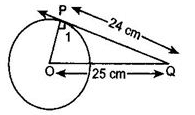
- a)10 cm
- b)8 cm
- c)7 cm
- d)6 cm
Correct answer is option 'C'. Can you explain this answer?
From a point Q, the length of tangent to a circle is 24 cm and the distance of Q from the centre is 25 cm, radius of circle is :
a)
10 cm
b)
8 cm
c)
7 cm
d)
6 cm

|
Anjana Bajaj answered |
Here ∠OPQ = 90° [Tangent makes right angle with the radius at the point of contact]
∴ OQ2 = OP2 + PQ2 (25)2 = OP2 + (24)2
⇒ OP2 = 676 - 576 = 49
⇒ OP = 7 cm Therefore, the radius of the circle is 7 cm
∴ OQ2 = OP2 + PQ2 (25)2 = OP2 + (24)2
⇒ OP2 = 676 - 576 = 49
⇒ OP = 7 cm Therefore, the radius of the circle is 7 cm
A tangent PQ at point of contact P to a circle of radius 12 cm meets the line through centre O to a point Q such that OQ = 20 cm, length of tangent PQ is : 
- a)15 cm
- b)12 cm
- c)16 cm
- d)13 cm
Correct answer is option 'C'. Can you explain this answer?
A tangent PQ at point of contact P to a circle of radius 12 cm meets the line through centre O to a point Q such that OQ = 20 cm, length of tangent PQ is :
a)
15 cm
b)
12 cm
c)
16 cm
d)
13 cm

|
Debanshi Sen answered |
Since op is perpendicular to PQ, the ∠OPQ = 90°
Now, in right angled triangle OPQ,
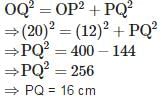
Now, in right angled triangle OPQ,

If PQR is a tangent to a circle at Q whose centre is O, AB is a chord parallel to PR and ∠BQR = 60∘, then ∠AQB is equal to
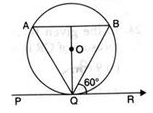
- a)60∘
- b)45∘
- c)90∘
- d)30∘
Correct answer is option 'A'. Can you explain this answer?
If PQR is a tangent to a circle at Q whose centre is O, AB is a chord parallel to PR and ∠BQR = 60∘, then ∠AQB is equal to

a)
60∘
b)
45∘
c)
90∘
d)
30∘

|
Anmol Chatterjee answered |
Since AB II PA and BQ is intersectin.
∴ ∠BQR = LQBA = 60° [Alternate angles]
And ∠BQR = ∠QAB = 60° [Alternate segment theorem] Now, in triangle AQB,
∠AQB + ∠QBA + ∠BAQ = 180°
⇒ ∠AQ,B + 60° + 60° = 180°
⇒ ∠LAQB = 60°
∴ ∠BQR = LQBA = 60° [Alternate angles]
And ∠BQR = ∠QAB = 60° [Alternate segment theorem] Now, in triangle AQB,
∠AQB + ∠QBA + ∠BAQ = 180°
⇒ ∠AQ,B + 60° + 60° = 180°
⇒ ∠LAQB = 60°
How the tangent at any point of a circle and radius through the point is related?- a)perpendicular to each other
- b)parallel to each other
- c)having same length
- d)none of these
Correct answer is option 'A'. Can you explain this answer?
How the tangent at any point of a circle and radius through the point is related?
a)
perpendicular to each other
b)
parallel to each other
c)
having same length
d)
none of these
|
|
Rohit Sharma answered |
The tangent at any point of a circle and the radius through this point are perpendicular to each other as shown below:
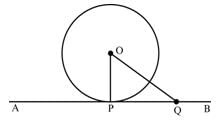
In the figure above,
∠OPA +∠OPQ = 180∘ ........(1) [Linear pair angle]
Also, ∠OPA = ∠OPQ ......(2)
∴ ∠OPA +∠OPQ = 180∘
2 ×∠OPQ = 180∘
∠OPQ = 90∘
Hence, OP is perpendicular to PQ ⇒ OP is perpendicular to AB.

In the figure above,
∠OPA +∠OPQ = 180∘ ........(1) [Linear pair angle]
Also, ∠OPA = ∠OPQ ......(2)
∴ ∠OPA +∠OPQ = 180∘
2 ×∠OPQ = 180∘
∠OPQ = 90∘
Hence, OP is perpendicular to PQ ⇒ OP is perpendicular to AB.
What is the area of circle in which the difference between the radius and circumference of the circle be 37 cm?- a)144 cm2
- b)154 cm2
- c)124 cm2
- d)224 cm2
Correct answer is option 'B'. Can you explain this answer?
What is the area of circle in which the difference between the radius and circumference of the circle be 37 cm?
a)
144 cm2
b)
154 cm2
c)
124 cm2
d)
224 cm2
|
|
Priyanka Kapoor answered |
Let r be the radius of the circle
2πr - r = 37
⇒ r (2π - 1) = 37
⇒
⇒
2πr - r = 37
⇒ r (2π - 1) = 37
⇒

⇒

⇒ r = 7 cm
Area = πr2 =  = 22 × 7 = 154 cm2.
= 22 × 7 = 154 cm2.
 = 22 × 7 = 154 cm2.
= 22 × 7 = 154 cm2.What is the value of y and x respectively in the given figure?
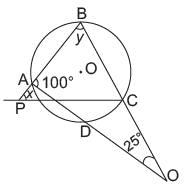
- a)x = 55°, y = 45°
- b)x = 45°, y = 55°
- c)x = 65°, y = 55°
- d)x = 55°, y = 65°
Correct answer is option 'B'. Can you explain this answer?
What is the value of y and x respectively in the given figure?


a)
x = 55°, y = 45°
b)
x = 45°, y = 55°
c)
x = 65°, y = 55°
d)
x = 55°, y = 65°
|
|
Priyanka Kapoor answered |
In ΔABO,
∠y + 25° + 100° = 180°
⇒ y = 55°
∠C + ∠A = 180° [∵ ABCD is cycle]
⇒ ∠ = 80°
In ΔPBC,
∠x + 55° + 80° = 180°
⇒ ∠x = 45°
∠y + 25° + 100° = 180°
⇒ y = 55°
∠C + ∠A = 180° [∵ ABCD is cycle]
⇒ ∠ = 80°
In ΔPBC,
∠x + 55° + 80° = 180°
⇒ ∠x = 45°
A bicycle wheel makes 5000 revolutions in moving 11 km. What is the radius of the wheel?- a)45 cm
- b)25 cm
- c)35 cm
- d)None of these
Correct answer is option 'C'. Can you explain this answer?
A bicycle wheel makes 5000 revolutions in moving 11 km. What is the radius of the wheel?
a)
45 cm
b)
25 cm
c)
35 cm
d)
None of these
|
|
Priyanka Kapoor answered |
Distance moved by wheel
= 2 × π × r × 5000 = 11000 m


= 2 × π × r × 5000 = 11000 m


= 35 cm
In the given figure, O is the centre of the circle, then ∠OZ is______.
- a)2 ∠XZY
- b)2 ∠Y
- c)2 ∠Z
- d)2 (∠XZY + ∠YXZ)
Correct answer is option 'D'. Can you explain this answer?
In the given figure, O is the centre of the circle, then ∠OZ is______.

a)
2 ∠XZY
b)
2 ∠Y
c)
2 ∠Z
d)
2 (∠XZY + ∠YXZ)
|
|
Ritu Saxena answered |
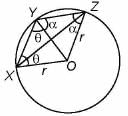
OX= OY = OZ = r (radius of circle)
Taking ∠X = θ and ∠Z = α
Then in ΔYXO, OX = OY ⇒ ∠X = ∠OYX = θ
Now, in ΔOZY OZ= OY⇒ ∠Z= ∠OYZ = α
Now, XOZY is a quadrilateral,
⇒ ∠X+∠Y+ ∠Z+∠O = 360°
⇒ θ + θ + α + α +∠O = 360°
⇒ ∠O = 360° - 2(α + θ)
⇒ ∠O = 360° - 2 (∠OZX + ∠XZY + ∠OXZ + ∠ZXY)
⇒ ∠O = 360° - 2 (∠OZX + ∠OXZ) - 2(∠XZY + ∠ZXY)
⇒ ∠O = 360° - 2(180° - ∠O) - 2(∠XZY + ∠ZXY)
⇒ ∠O = 360° - 360° + 2∠O - 2(∠XZY + ∠ZXY)
Taking ∠X = θ and ∠Z = α
Then in ΔYXO, OX = OY ⇒ ∠X = ∠OYX = θ
Now, in ΔOZY OZ= OY⇒ ∠Z= ∠OYZ = α
Now, XOZY is a quadrilateral,
⇒ ∠X+∠Y+ ∠Z+∠O = 360°
⇒ θ + θ + α + α +∠O = 360°
⇒ ∠O = 360° - 2(α + θ)
⇒ ∠O = 360° - 2 (∠OZX + ∠XZY + ∠OXZ + ∠ZXY)
⇒ ∠O = 360° - 2 (∠OZX + ∠OXZ) - 2(∠XZY + ∠ZXY)
⇒ ∠O = 360° - 2(180° - ∠O) - 2(∠XZY + ∠ZXY)
⇒ ∠O = 360° - 360° + 2∠O - 2(∠XZY + ∠ZXY)
Match the columns.
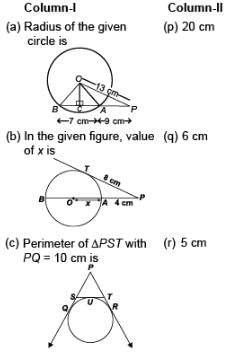
- a)(a) → (p), (b) → (r), (c) → (q)
- b)(a) → (r), (b) → (q), (c) → (p)
- c)(a) → (q), (b) → (r), (c) → (p)
- d)(a) → (r), (b) → (p), (c) → (q)
Correct answer is option 'B'. Can you explain this answer?
Match the columns.


a)
(a) → (p), (b) → (r), (c) → (q)
b)
(a) → (r), (b) → (q), (c) → (p)
c)
(a) → (q), (b) → (r), (c) → (p)
d)
(a) → (r), (b) → (p), (c) → (q)
|
|
Ritu Saxena answered |
(a) Draw OC perpendicular on AB,
In Δ OBC & Δ OAC
∠OCB = ∠OCA (each 90°)
OB = OA (radii of same circle)
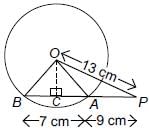
OC is common side in both triangles
∴ ΔOBC ≅ ΔOAC (RHS congruence)

Now, in ΔOCA (OA)2 = (OC)2 + (CA)2

Hence, radius of circle = 5 cm
(b) : In ΔOPT,
(OP)2 = (OT)2 + (PT)2
⇒ (x + 4)2 = x2 + (8)2
⇒ x2 + 16 + 8x = x2 + 64
⇒ 8x = 48 ⇒ x = 6 cm
(c) : PQ = 10 cm
We know, length of tangents drawn from an external point to a circle are equal.
⇒ PQ = PR ...(i)
Also, SQ = SU ...(ii)
and TU = TR ...(iii)
Now, perimeter of DPST
= PS + ST + PT = PS + SU + UT + PT
= PS + SQ + TR + PT (Using (ii) & (iii))
= PQ + PR = PQ + PQ (Using (i))
= 2 PQ = 2 × 10 = 20 cm.
In Δ OBC & Δ OAC
∠OCB = ∠OCA (each 90°)
OB = OA (radii of same circle)

OC is common side in both triangles
∴ ΔOBC ≅ ΔOAC (RHS congruence)

Now, in ΔOCA (OA)2 = (OC)2 + (CA)2

Hence, radius of circle = 5 cm
(b) : In ΔOPT,
(OP)2 = (OT)2 + (PT)2
⇒ (x + 4)2 = x2 + (8)2
⇒ x2 + 16 + 8x = x2 + 64
⇒ 8x = 48 ⇒ x = 6 cm
(c) : PQ = 10 cm
We know, length of tangents drawn from an external point to a circle are equal.
⇒ PQ = PR ...(i)
Also, SQ = SU ...(ii)
and TU = TR ...(iii)
Now, perimeter of DPST
= PS + ST + PT = PS + SU + UT + PT
= PS + SQ + TR + PT (Using (ii) & (iii))
= PQ + PR = PQ + PQ (Using (i))
= 2 PQ = 2 × 10 = 20 cm.
Two chords AB and CD of a circle intersect at an external point P as shown in figure. If AB = 8 cm, BP = 10 cm, PD = 12 cm. What is length of CP?
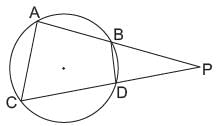
- a)15 cm
- b)12 cm
- c)18 cm
- d)10 cm
Correct answer is option 'A'. Can you explain this answer?
Two chords AB and CD of a circle intersect at an external point P as shown in figure. If AB = 8 cm, BP = 10 cm, PD = 12 cm. What is length of CP?


a)
15 cm
b)
12 cm
c)
18 cm
d)
10 cm
|
|
Priyanka Kapoor answered |
For any external point P,
AP × BP = PD × PC
⇒ (AB + BP) × BP = 12 × PC
⇒ (8 +10) × 10 = 12 × PC
⇒ PC = = 15 cm.
= 15 cm.
AP × BP = PD × PC
⇒ (AB + BP) × BP = 12 × PC
⇒ (8 +10) × 10 = 12 × PC
⇒ PC =
 = 15 cm.
= 15 cm.In the given figure, a circle touches all four sides of a quadrilateral PQRS, whose sides are PQ = 6.5 cm, QR = 7.3 cm, and PS = 4.2 cm, then RS is equal to
- a)4.7 cm.
- b)7.3 cm.
- c)5.3 cm.
- d)5 cm.
Correct answer is option 'D'. Can you explain this answer?
In the given figure, a circle touches all four sides of a quadrilateral PQRS, whose sides are PQ = 6.5 cm, QR = 7.3 cm, and PS = 4.2 cm, then RS is equal to
a)
4.7 cm.
b)
7.3 cm.
c)
5.3 cm.
d)
5 cm.

|
Mahesh Basu answered |
Let P,Q,R,S be the points where the circle touches the quadrilateral .From a point out side of the circle the two tangents to the circle are equal.
AP = AS,BP = BQ , CR = CQ , and DR = DS
Adding AP + BP + CR + DR = AS + BQ + CQ + DS
AB + CD = AD + BC
6 + 4 = AD + 7
AD = 3 cm .
In the adjoining figure, the measure Of PR is 
- a)18 cm.
- b)12 cm.
- c)10 cm.
- d)16 cm.
Correct answer is option 'D'. Can you explain this answer?
In the adjoining figure, the measure Of PR is
a)
18 cm.
b)
12 cm.
c)
10 cm.
d)
16 cm.

|
Niharika Mehta answered |
Here ∠Q = 90° [Angle between tangent and radius through the point of contact] Now, in triangle OPQ, OP2 = QO2 + PQ2
⇒ OP2 = (6)2 + (8)2 = 36 + 64 = 100
⇒ OP = 10 cm
∴ PR = OP + OR = OP + OQ [OR = OQ = Radii]
⇒ PR = 10+6 = 16cm
⇒ OP2 = (6)2 + (8)2 = 36 + 64 = 100
⇒ OP = 10 cm
∴ PR = OP + OR = OP + OQ [OR = OQ = Radii]
⇒ PR = 10+6 = 16cm
A tangent PQ at a point P o a circle of radius 5 cm meets a line through the centre O at point Q, so that OQ = 12 cm. find the length PQ. 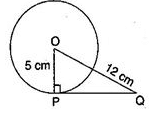
- a)

- b)13 cm
- c)

- d)26 cm.
Correct answer is option 'C'. Can you explain this answer?
A tangent PQ at a point P o a circle of radius 5 cm meets a line through the centre O at point Q, so that OQ = 12 cm. find the length PQ.
a)
b)
13 cm
c)
d)
26 cm.

|
Suyash Kapoor answered |
∠OPQ = 90° [Angle between tangent and radius through the point of contact]


In the given figure, AT is a tangent to the circle with centre O such that OT = 4 cm and ∠OTA = 30o. Then AT is equal to :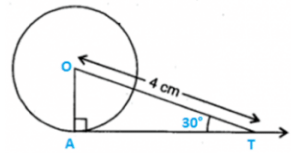
- a)4√3 cm
- b)2√3 cm
- c)4 cm
- d)2 cm
Correct answer is option 'B'. Can you explain this answer?
In the given figure, AT is a tangent to the circle with centre O such that OT = 4 cm and ∠OTA = 30o. Then AT is equal to :
a)
4√3 cm
b)
2√3 cm
c)
4 cm
d)
2 cm

|
Pritam Khanna answered |
Construction : Joined OA.
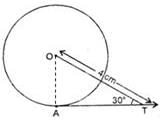

Since OA is perpendicular to AT. then ∠OAP = 90°
In right angled triangle OAT

In right angled triangle OAT

In figure, AB is a chord of a circle and AT is a tangent at A such that ∠BAT = 60o, measure of ∠ACB is :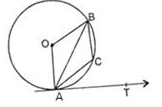
- a)90∘
- b)150∘
- c)110∘
- d)120∘
Correct answer is option 'D'. Can you explain this answer?
In figure, AB is a chord of a circle and AT is a tangent at A such that ∠BAT = 60o, measure of ∠ACB is :
a)
90∘
b)
150∘
c)
110∘
d)
120∘

|
Debanshi Sen answered |
Since OA is perpendicular to AT. then ∠OAT = 90°
⇒ ∠OAB + ∠BAT = 90°
⇒ ∠OAB + 60° = 90° ⇒ ∠OAB = 30°
∴ ∠OAB = ∠O8A = 30" [Angles opposite to radii]
∴ ∠OAB = 180° - (30° +30° ) = 120° [Angle sum property of a triangle]
∴ Reflex ∠AOB = 360° - 120° = 240°
Now, since the degree measure of an arc of a circle is twice the angle subtended by it any point of the alternate segment of the circle with respect to the arc.
∴ Reflex ∠AOB = 2∠ACB ⇒ 240° = 2∠ACB ⇒ ∠ACB = 120°
⇒ ∠OAB + ∠BAT = 90°
⇒ ∠OAB + 60° = 90° ⇒ ∠OAB = 30°
∴ ∠OAB = ∠O8A = 30" [Angles opposite to radii]
∴ ∠OAB = 180° - (30° +30° ) = 120° [Angle sum property of a triangle]
∴ Reflex ∠AOB = 360° - 120° = 240°
Now, since the degree measure of an arc of a circle is twice the angle subtended by it any point of the alternate segment of the circle with respect to the arc.
∴ Reflex ∠AOB = 2∠ACB ⇒ 240° = 2∠ACB ⇒ ∠ACB = 120°
In the following figure, PT is of length 8 cm. OP is 10 cm. Then the radius of the circle is___.
- a)2 cm
- b)18 cm
- c)(5/4) cm
- d)6 cm
Correct answer is option 'D'. Can you explain this answer?
In the following figure, PT is of length 8 cm. OP is 10 cm. Then the radius of the circle is___.

a)
2 cm
b)
18 cm
c)
(5/4) cm
d)
6 cm
|
|
Priyanka Kapoor answered |
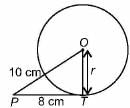
Since OT is perpendicular to FT, Using pythagoras theorem,
100 = 64 + r2
100 = 64 + r2
∴ r = 6 cm
In the given figure, PT touches the circle at R whose centre is O. Diameter SQ when produced meets PT at P. Given ∠SPR = x° and ∠QRP = y°. Then,
- a)x° + 2y° = 90°
- b)2x° + y° = 90°
- c)x° + y° = 120°
- d)3x°+2y° = 120°
Correct answer is option 'A'. Can you explain this answer?
In the given figure, PT touches the circle at R whose centre is O. Diameter SQ when produced meets PT at P. Given ∠SPR = x° and ∠QRP = y°. Then,

a)
x° + 2y° = 90°
b)
2x° + y° = 90°
c)
x° + y° = 120°
d)
3x°+2y° = 120°
|
|
Vivek Bansal answered |
Consider chord QR
∴∠QRP = ∠QSR
⇒ ∠QSR = y° [∴ QRP = y°]
⇒ ∠PSR = y°
Since angle in a semicircle is a right angle.
∴∠QRS = 90°
Now, ∠PRS = ∠QRP + ∠QRS
⇒ ∠PRS = y° + 90°
In ΔPRS, we have
∠SPR + ∠PRS + ∠PSR = 180°
⇒ x° + y°+ 90° + y° = 180°
⇒ x° + 2y° = 90°
If O is the centre of a circle, AOC is its diameter and B is a point on the circle such that ∠ACB = 50°. If AT is the tangent to the circle at the point A, then ∠BAT =

- a)40°
- b)50°
- c)60°
- d)65°
Correct answer is option 'B'. Can you explain this answer?
If O is the centre of a circle, AOC is its diameter and B is a point on the circle such that ∠ACB = 50°. If AT is the tangent to the circle at the point A, then ∠BAT =


a)
40°
b)
50°
c)
60°
d)
65°
|
|
Ritu Saxena answered |
∠ABC = 90° [Angle in a semicircle ]
In ∆ ABC, we have
∠ACB + ∠CAB + ∠ABC = 180°

⇒ 50° + ∠CAB + 90° = 180°
⇒ ∠CAB = 40°
Now, ∠CAT = 90° ⇒ ∠CAB + ∠BAT = 90°
⇒ 40° + ∠BAT = 90°⇒ ∠BAT = 50°
In ∆ ABC, we have
∠ACB + ∠CAB + ∠ABC = 180°

⇒ 50° + ∠CAB + 90° = 180°
⇒ ∠CAB = 40°
Now, ∠CAT = 90° ⇒ ∠CAB + ∠BAT = 90°
⇒ 40° + ∠BAT = 90°⇒ ∠BAT = 50°
What is the area of shaded region if ABCD is a square of side 14 cm and APD and BPC are semi circles?
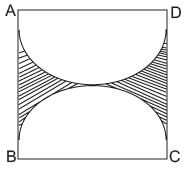
- a)52 cm2
- b)32 cm2
- c)42 cm2
- d)62 cm2
Correct answer is option 'C'. Can you explain this answer?
What is the area of shaded region if ABCD is a square of side 14 cm and APD and BPC are semi circles?


a)
52 cm2
b)
32 cm2
c)
42 cm2
d)
62 cm2
|
|
Priyanka Kapoor answered |
Area of the shaded region = Area of square ABCD - Area of two semicircles

= 196 - 154 = 42 cm2

= 196 - 154 = 42 cm2
In the given figure, the pair of tangents A to a circle with centre O are perpendicular to each other and length of each tangent is 5 cm, then the radius of the circle is :

- a)2.5 cm
- b)7.5 cm
- c)5 cm
- d)10 cm
Correct answer is option 'C'. Can you explain this answer?
In the given figure, the pair of tangents A to a circle with centre O are perpendicular to each other and length of each tangent is 5 cm, then the radius of the circle is :

a)
2.5 cm
b)
7.5 cm
c)
5 cm
d)
10 cm

|
Pritam Khanna answered |
Construction: Joined OP and OQ.
Here OP ⊥ AP and OC⊥AQ and PA ⊥ AQ Also AP = AQ
Therefore. APOQ is a square. ⇒ AP = OP = OQ = 5 cm
Here OP ⊥ AP and OC⊥AQ and PA ⊥ AQ Also AP = AQ
Therefore. APOQ is a square. ⇒ AP = OP = OQ = 5 cm
In the figure given alongside the length of PR is
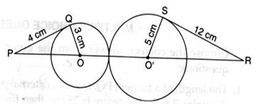
- a)24 cm.
- b)28 cm.
- c)26 cm.
- d)20 cm.
Correct answer is option 'C'. Can you explain this answer?
In the figure given alongside the length of PR is


a)
24 cm.
b)
28 cm.
c)
26 cm.
d)
20 cm.

|
Saumya Chakraborty answered |
Here ∠Q = 90° and LS = 90° [Angle between tangent and radius through the point of contact]
Now, in triangle OPQ, OP2 = OQ2 + QP2
⇒ OP2 = (3)2 + (4)2
⇒ OP2 = 16 + 9 = 25
⇒ OP = 5 cm Again in triangle RSO', O'R2 = O'S2 + FS2
⇒ O'R2 = (5)2 + (12)2
⇒ O'R2 = 25 +144 = 169
⇒ O'R = 13 cm
∴ PR = OP+OQ+O's+OR = 5+ 3+ 5+ 13 = 26 m
Now, in triangle OPQ, OP2 = OQ2 + QP2
⇒ OP2 = (3)2 + (4)2
⇒ OP2 = 16 + 9 = 25
⇒ OP = 5 cm Again in triangle RSO', O'R2 = O'S2 + FS2
⇒ O'R2 = (5)2 + (12)2
⇒ O'R2 = 25 +144 = 169
⇒ O'R = 13 cm
∴ PR = OP+OQ+O's+OR = 5+ 3+ 5+ 13 = 26 m
A tangent PQ at a point P of a circle of radius 5 cm meets a line through the centre O at a point Q, such that OQ = 15 cm. Length of PQ is
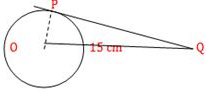
- a)12 cm
- b)13m
- c)10√2 cm
- d)none
Correct answer is option 'C'. Can you explain this answer?
A tangent PQ at a point P of a circle of radius 5 cm meets a line through the centre O at a point Q, such that OQ = 15 cm. Length of PQ is

a)
12 cm
b)
13m
c)
10√2 cm
d)
none

|
Abhiram Gupta answered |
Since OP is perpendicular to PQ, then ∠OPQ = 90°
Now, in triangle OPQ.
OQ2 = OP2 + PQ2 ⇒ (15)2 = (5)2 + PQ2 ⇒ PQ2 = 225 - 25
⇒ PQ2 = 200 ⇒ PQ = 10√2cm
Now, in triangle OPQ.
OQ2 = OP2 + PQ2 ⇒ (15)2 = (5)2 + PQ2 ⇒ PQ2 = 225 - 25
⇒ PQ2 = 200 ⇒ PQ = 10√2cm
In the given figure, RQ is a tangent to the circle with centre O. If SQ = 6 cm and RQ = 4 cm, then OR is equal to
- a)2.5 cm.
- b)12 cm.
- c)5 cm.
- d)10 cm.
Correct answer is option 'C'. Can you explain this answer?
In the given figure, RQ is a tangent to the circle with centre O. If SQ = 6 cm and RQ = 4 cm, then OR is equal to
a)
2.5 cm.
b)
12 cm.
c)
5 cm.
d)
10 cm.

|
Kds Coaching answered |
Given: SQ = 6 cm and RQ = 4 cm.
To find the length of OR, we can use the properties of the right triangle OQR, where:
- OQ is the radius of the circle.
- Since SQ = 6 cm, then OQ = OS = 6/2 = 3 cm.
- Angle Q is a right angle (90°).
Using the Pythagorean theorem in triangle OQR:
- OR2 = QR2 + OQ2
- Substituting the known values: OR2 = (4 cm)2 + (3 cm)2
- Calculating: OR2 = 16 + 9 = 25
- Thus, OR = √25 = 5 cm.
The final result is that OR is equal to 5 cm.
In the given figure, O is the centre of the circle and TP is the tangent to the circle from an external point T. If ∠PBT = 30°, then BA : AT is

- a)3 : 1
- b)4 : 1
- c)2 : 1
- d)3 : 2
Correct answer is option 'C'. Can you explain this answer?
In the given figure, O is the centre of the circle and TP is the tangent to the circle from an external point T. If ∠PBT = 30°, then BA : AT is


a)
3 : 1
b)
4 : 1
c)
2 : 1
d)
3 : 2
|
|
Ritu Saxena answered |
∠BPA = 90° (Angle in semicircle)
In ∆ BPA, ∠ABP + ∠BPA + ∠PAB = 180°
⇒ 30° + 90° + ∠PAB = 180°
⇒ ∠PAB = 60°
Also, ∠POA = 2∠PBA
⇒ ∠POA = 2 × 30° = 60°
⇒ OP = AP ...(i)
(side opposite to equal angles)

In ∆OPT, ∠OPT = 90°
∠POT = 60° and ∠PTO = 30° [angle sum property of a D]
Also ∠APT + ∠ATP = ∠PAO [exterior angle property]
∴ ∠APT + 30°= 60° ⇒ ∠APT = 30°
∴ AP = AT ...(ii) (side opposite to equal angles)
From (i) and (ii), AT = OP = radius of the circle; and AB = 2r
⇒ AB = 2AT ⇒ AB/AT = 2 ⇒ AB : AT = 2 :1
In ∆ BPA, ∠ABP + ∠BPA + ∠PAB = 180°
⇒ 30° + 90° + ∠PAB = 180°
⇒ ∠PAB = 60°
Also, ∠POA = 2∠PBA
⇒ ∠POA = 2 × 30° = 60°
⇒ OP = AP ...(i)
(side opposite to equal angles)

In ∆OPT, ∠OPT = 90°
∠POT = 60° and ∠PTO = 30° [angle sum property of a D]
Also ∠APT + ∠ATP = ∠PAO [exterior angle property]
∴ ∠APT + 30°= 60° ⇒ ∠APT = 30°
∴ AP = AT ...(ii) (side opposite to equal angles)
From (i) and (ii), AT = OP = radius of the circle; and AB = 2r
⇒ AB = 2AT ⇒ AB/AT = 2 ⇒ AB : AT = 2 :1
Two concentric circles of radii a and b, where a > b, are given. The length of a chord of the larger circle which touches the other circle is- a)

- b)

- c)

- d)

Correct answer is option 'B'. Can you explain this answer?
Two concentric circles of radii a and b, where a > b, are given. The length of a chord of the larger circle which touches the other circle is
a)

b)

c)

d)

|
|
Ritu Saxena answered |
In figure, AB is a chord of circle C1 which is a tangent to C2.
Since, tangent is perpendicular to radius through point of contact
∴ ∠OCA = 90° ⇒ OA = a, OC = b
In ∆OCA, (OA)2 = (OC)2 + (AC)2
⇒ a2 = b2 + (AC)2 ⇒ AC =
∴ Length of chord AB = 2AC = 2

Since, tangent is perpendicular to radius through point of contact
∴ ∠OCA = 90° ⇒ OA = a, OC = b
In ∆OCA, (OA)2 = (OC)2 + (AC)2
⇒ a2 = b2 + (AC)2 ⇒ AC =

∴ Length of chord AB = 2AC = 2


Chapter doubts & questions for Circles - International Mathematics Olympiad (IMO) for Class 10 2025 is part of Class 10 exam preparation. The chapters have been prepared according to the Class 10 exam syllabus. The Chapter doubts & questions, notes, tests & MCQs are made for Class 10 2025 Exam. Find important definitions, questions, notes, meanings, examples, exercises, MCQs and online tests here.
Chapter doubts & questions of Circles - International Mathematics Olympiad (IMO) for Class 10 in English & Hindi are available as part of Class 10 exam.
Download more important topics, notes, lectures and mock test series for Class 10 Exam by signing up for free.
International Mathematics Olympiad (IMO) for Class 10
28 videos|149 docs|72 tests
|
Related Class 10 Content

Contact Support
Our team is online on weekdays between 10 AM - 7 PM
Typical reply within 3 hours
|
Free Exam Preparation
at your Fingertips!
Access Free Study Material - Test Series, Structured Courses, Free Videos & Study Notes and Prepare for Your Exam With Ease

 Join the 10M+ students on EduRev
Join the 10M+ students on EduRev
|

|
Create your account for free
OR
Forgot Password
OR
Signup on EduRev and stay on top of your study goals
10M+ students crushing their study goals daily


 of the area of the circle, then what is the sector angle of the circle?
of the area of the circle, then what is the sector angle of the circle?
